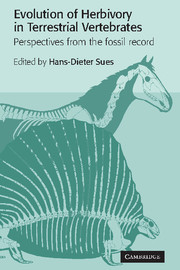Book contents
- Frontmatter
- Contents
- List of contributors
- Preface
- 1 Herbivory in terrestrial vertebrates: an introduction
- 2 Herbivory in late Paleozoic and Triassic terrestrial vertebrates
- 3 Prosauropod dinosaurs and iguanas: speculations on the diets of extinct reptiles
- 4 The evolution of sauropod feeding mechanisms
- 5 Plant-eaters and ghost lineages: dinosaurian herbivory revisited
- 6 Dental constraints in the early evolution of mammalian herbivory
- 7 Patterns in the evolution of herbivory in large terrestrial mammals: the Paleogene of North America
- 8 Origin and evolution of the grazing guild in Cenozoic New World terrestrial mammals
- Taxonomic index
- Subject index
3 - Prosauropod dinosaurs and iguanas: speculations on the diets of extinct reptiles
Published online by Cambridge University Press: 22 October 2009
- Frontmatter
- Contents
- List of contributors
- Preface
- 1 Herbivory in terrestrial vertebrates: an introduction
- 2 Herbivory in late Paleozoic and Triassic terrestrial vertebrates
- 3 Prosauropod dinosaurs and iguanas: speculations on the diets of extinct reptiles
- 4 The evolution of sauropod feeding mechanisms
- 5 Plant-eaters and ghost lineages: dinosaurian herbivory revisited
- 6 Dental constraints in the early evolution of mammalian herbivory
- 7 Patterns in the evolution of herbivory in large terrestrial mammals: the Paleogene of North America
- 8 Origin and evolution of the grazing guild in Cenozoic New World terrestrial mammals
- Taxonomic index
- Subject index
Summary
Introduction
A thorough knowledge of extant taxa is required when attempting paleobiological interpretations of extinct animals (Lauder 1995; Witmer 1995). Skeletal material, though informative, can provide only a limited amount of information on soft-tissue and behavioral characteristics. It is not possible to identify with certainty the actual diet of any extinct animal because we cannot observe the animal feeding. Fossilized gut contents (enterolites) and feces (coprolites) may provide some dietary information, but convincing enterolites are rare and coprolites are almost never associated with the animal that produced them. In some cases, direct comparison of the feeding adaptations of extinct taxa with closely related extant forms (‘Extant Phylogenetic Bracket’ approach sensu Witmer 1995) is possible, allowing these interpretations to be made with some confidence (e.g., between extinct and extant mammals). Some groups, however, have no present-day representatives for relevant comparison. For example, study of extant birds and crocodilians provides only limited insight into the paleobiology of non-avian dinosaurs. In cases where the phylogenetic approach to assessing function in extinct organisms is not feasible, there is a tendency to rely on a historical biomechanical modeling (Weishampel 1995). Such modeling is often based on the identification and study of suitable extant analogues. The choice of extant taxa for comparison, however, is often limited, and many studies are forced to utilize animal models that may be distantly related to the extinct taxon under consideration. This chapter deals with one such model — the relationship between tooth form and diet in herbivorous reptiles.
- Type
- Chapter
- Information
- Evolution of Herbivory in Terrestrial VertebratesPerspectives from the Fossil Record, pp. 42 - 78Publisher: Cambridge University PressPrint publication year: 2000
- 91
- Cited by



